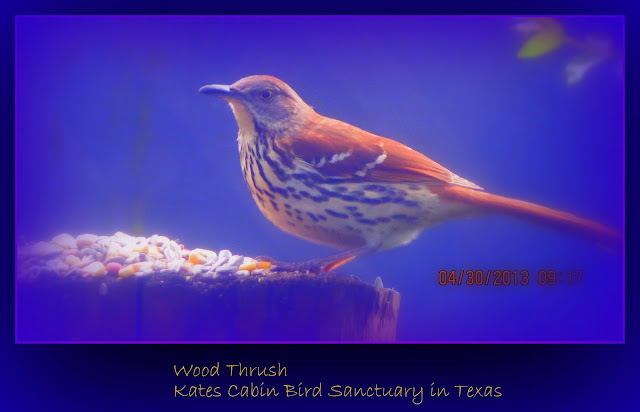HI EVERYBODY!!
http://en.wikipedia.org/wiki/Wood_Thrush
Wood Thrush
From Wikipedia, the free encyclopedia
The Wood Thrush, Hylocichla mustelina, is a North American passerine bird. It is closely related to other thrushes such as the American Robin and is widely distributed across North America, wintering in Central America and southern Mexico. The Wood Thrush is the official bird of the District of Columbia.[2]
The Wood Thrush is a medium-sized thrush, with brown upper parts with mottled brown and white underparts. The male and female are similar in appearance. The song of the male is often cited as one of the most beautiful in North America.[citation needed]
The Wood Thrush is an omnivore, and feeds preferentially on soil invertebrates and larvae, but will also eat fruits. In the summer, it feeds on insects continuously in order to meet daily metabolic needs. It is solitary, but sometimes form mixed-species flocks. The Wood Thrush defends a territory that ranges in size from 800 to 28,000 square meters. The Wood Thrush is monogamous, and its breeding season begins in the spring; about 50% of all mated pairs are able to raise two broods, ranging in size from 2 to 4 chicks.[3]
| Wood Thrush | |
|---|---|
 | |
| Conservation status | |
| Scientific classification | |
| Kingdom: | Animalia |
| Phylum: | Chordata |
| Class: | Aves |
| Order: | Passeriformes |
| Family: | Turdidae |
| Genus: | Hylocichla Baird, 1864 |
| Species: | H. mustelina |
| Binomial name | |
| Hylocichla mustelina (Gmelin, 1789) | |
The Barn Swallow
http://en.wikipedia.org/wiki/Barn_Swallow
Barn Swallow
From Wikipedia, the free encyclopedia
The Barn Swallow (Hirundo rustica) is the most widespread species of swallow in the world.[2] It is a distinctive passerine bird with blue upperparts, a long, deeply forked tail and curved, pointed wings. It is found in Europe, Asia, Africa and the Americas.[2] In Anglophone Europe it is just called theSwallow; in Northern Europe it is the only common species called a "swallow" rather than a "martin".[3]
There are six subspecies of Barn Swallow, which breed across the Northern Hemisphere. Four are strongly migratory, and their wintering grounds cover much of the Southern Hemisphere as far south as central Argentina, the Cape Province of South Africa, and northern Australia.[2] Its huge range means that the Barn Swallow is not endangered, although there may be local population declines due to specific threats.
The Barn Swallow is a bird of open country which normally uses man-made structures to breed and consequently has spread with human expansion. It builds a cup nest from mud pellets in barns or similar structures and feeds on insects caught in flight.[4] This species lives in close association with humans, and its insect-eating habits mean that it is tolerated by man; this acceptance was reinforced in the past by superstitions regarding the bird and its nest. There are frequent cultural references to the Barn Swallow in literary and religious works due to both its living in close proximity to humans and its annual migration.[5] The Barn Swallow is the national bird of Austria and Estonia.
| Barn Swallow | |
|---|---|
 | |
| European subspecies, H. r. rustica in Denmark | |
| Conservation status | |
| Scientific classification | |
| Kingdom: | Animalia |
| Phylum: | Chordata |
| Class: | Aves |
| Order: | Passeriformes |
| Family: | Hirundinidae |
| Genus: | Hirundo |
| Species: | H. rustica |
| Binomial name | |
| Hirundo rustica Linnaeus, 1758 | |
 | |
Breeding range
Resident year-round
Non-breeding range
| |
http://en.wikipedia.org/wiki/Acca_sellowiana
Acca sellowiana
From Wikipedia, the free encyclopedia
| Acca sellowiana | |
|---|---|
 | |
| Fruit | |
| Scientific classification | |
| Kingdom: | Plantae |
| (unranked): | Angiosperms |
| (unranked): | Eudicots |
| (unranked): | Rosids |
| Order: | Myrtales |
| Family: | Myrtaceae |
| Genus: | Acca |
| Species: | A. sellowiana |
| Binomial name | |
| Acca sellowiana (O.Berg) Burret | |
| Synonyms | |
http://www.youtube.com/watch?v=u3eqSevtuKU
Uploaded on Apr 9, 2009
David Attenborough presents a ten-part insight into the evolution and behaviours of birds. In this first programme, computer graphics recreate the period 150 million years ago when small, fast-running dinosaurs evolved feathers and took to the air. In New Zealand, David examines the environment required by birds which have survived without recourse to flight, and enjoys a midnight encounter with a kiwi, captured on a starlight-sensitive camera.
...this is brendasue signing off from Rainbow Creek. See You next time. Remember to feed the Birds extra feed while they travel. Photograph what You see!
Of course, one more great performance from
Google You Tube Site:
Google You Tube Site:
O+O

















No comments:
Post a Comment
Hi Everybody! Please say hello and follow so I know you are here! Due to the inconsideration of people trying to put commercials on my blog comment area, I have restricted use of anonymous posts. Sorry that some hurt all.
My public email is katescabin@gmail.com No spammers or trolls